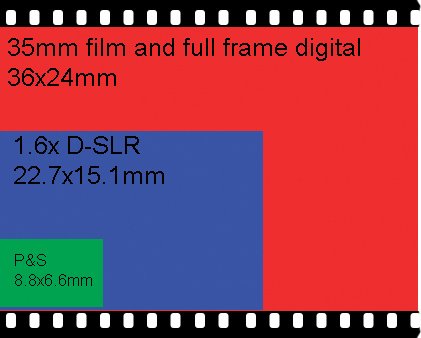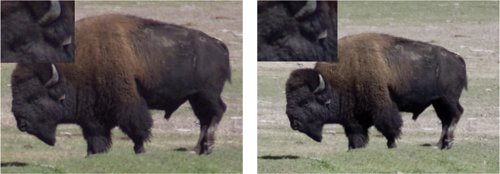Image Sensors
| Now that you've narrowed down your price-pain threshold, let's look at underlying technologies. The type of image sensor in your camera has great impact on the quality of the images you get. The two primary sensor types are CCD (Charge Coupled Device) and CMOS (Complementary Metal Oxide Semiconductor). CCD and CMOS differ in the ways they record and process light, but the basic layout and capture methods are similar. CCD is the most common sensor in digicams and lower-pixel count dSLRs. It is also the less expensive of the two sensors. CMOS is used by many of the high-pixel count dSLRs from Canon, Nikon, and Kodak. Figure 1.9 compares the two types of sensors. Figure 1.9. CCD and CMOS sensors differ in how the data is processed.
CCD and CMOS sensors are made up of photosites, each of which contains a photodiode to collect the light and convert it into electrons. The transfer cell collects the electrons and converts them into the digital values that make up the image. CMOS does more of the computational work at the photosite itself instead of making the transfer cell carry the load. The advantages and disadvantages to CCD and CMOS sensors are as follows:
How Sensors WorkPhotosites are laid out in a grid of rows and columns as shown in Figure 1.10. Each photosite contains a photodiode, which collects the light as photons, and a holding cell to store that light as electrons. An exception to the typical grid is the method used by Fuji to increase the dynamic range by using two photodiodes for each photosite. In most cameras, a mosaic of color filters is laid over each photosite to provide color information to the image. The most common layout is the Bayer pattern, which uses twice the number of green filters as red. The filters are laid out in a green/blue row followed by red/green row, as shown in Figure 1.11. Figure 1.10. Photosites are commonly laid out in a grid pattern on the sensor. The exception to this is the Fuji sensor which uses a honeycomb pattern with two photodiodes for each pixel to increase dynamic range.
Figure 1.11. The Bayer pattern is the most commonly used filter system in digital sensors. There are twice as many green filters as there are red or blue because the human eye is most sensitive to green.
Although the Bayer pattern is by far the most commonly used filter array, there are other methods of recording the color values. Early CCD sensors used a three-pass system where each exposure was recorded three timesonce for red, once for green, and once for blue. These separate exposures were then combined to create a single color image. This method is still used in some cameras, notably in astrophotography to record faint celestial objects while minimizing noise, as well as some large- and medium-format digital backs that attach to a conventional camera. Because three separate exposures are required to produce a single image, this type of sensor doesn't work for handheld photography. In fact, it often requires that they be connected to a computer that does the processing work of combining each of the separate exposures into one image. Sensor and Photosite SizeThe size of the sensor helps to determine how large the individual photosites are and how densely they are packed together. Both size of the sensor and density of the photosites play an important role in the quality of the captured image. Smaller photosites are unable to gather as much light as larger photosites before filling up. When these sites are packed closer together, the overflow can affect the light being captured by the neighboring photosites. The majority of digicams, or point-and-shoot digital cameras, use a very small sensor that is approximately 8.8mm x 6.6mm, so image noise is frequently a problem. On the other hand, many dSLR models use a much larger sensor, measuring 23.4 x 16.7mm. Currently, only the Canon 5D and Canon 1Ds Mark II use full-frame sensors that have the same measurements as a frame of 35mm film: 24mm x 36mm. This larger sensor size allows lenses to be used with no extra magnification and also provides higher-resolution image files with larger photosites, thus producing a higher-quality image. Figure 1.12 shows the relative size of each of these sensors compared to a 35mm negative. Figure 1.12. Most sensors are smaller than conventional 35mm film. The larger the sensor, the more detail it can capture. As you can see from this example, digital SLRs have a significant advantage over the digicam in sensor size.
However, the single most important determination in image quality is the size of the individual photosites. Smaller photosites are unable to handle as much light before they spill over. This overfill is most commonly seen as blooming, which shows up in a digital image as a white glow that looks like a slight halo, as shown in Figure 1.13. This is not the same thing as chromatic aberration, which is seen as color fringing around areas with strong lighting, although the two effects are related in cause. You are most likely to see blooming and chromatic aberration when transitioning from strong light to dark areas, such as leaves against a bright sky. Because smaller photosites fill more quickly, they also have lower dynamic rangethere are fewer levels of light held before the photosite is saturated to full white. Although it's always best to choose a camera that minimizes these artifacts, I discuss later how to correct some of them in Adobe Photoshop. Figure 1.13. Blooming and chromatic aberration occurs when a photosite is flooded with more light than it can handle. Here you can see blooming on the chrome area (if you take your eyes off the cute doggie).
Figure 1.14 shows the difference between two cameras with the same resolution but different sensor sizes. The image on the left was taken with a digicam using the small sensor typical in these models. The image on the right was taken with a dSLR with a much larger sensor. The dSLR image is more resolute, has better color rendition, and contains smoother transitions along the edges where the tonality changes. Figure 1.14. The image on the right was captured with a digital SLR using a large sensor, and the left-hand image was captured with a compact camera and the typical small sensor size. As you can see, the digital SLR has captured much more detail thanks in large part to the larger photosites.
|
EAN: 2147483647
Pages: 91





